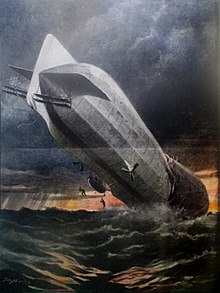
A Zeppelin is a type of rigid airship named after the German inventor Ferdinand von Zeppelin who pioneered rigid airship development at the beginning of the 20th century. Zeppelin's notions were first formulated in 1874 and developed in detail in 1893. They were patented in Germany in 1895 and in the United States in 1899. After the outstanding success of the Zeppelin design, the word zeppelin came to be commonly used to refer to all forms of rigid airships. Zeppelins were first flown commercially in 1910 by Deutsche Luftschiffahrts-AG (DELAG), the world's first airline in revenue service. By mid-1914, DELAG had carried over 10,000 fare-paying passengers on over 1,500 flights. During World War I, the German military made extensive use of Zeppelins as bombers and as scouts. Numerous bombing raids on Britain resulted in over 500 deaths.

LZ 129 Hindenburg was a German commercial passenger-carrying rigid airship, the lead ship of the Hindenburg class, the longest class of flying machine and the largest airship by envelope volume. It was designed and built by the Zeppelin Company on the shores of Lake Constance in Friedrichshafen, Germany, and was operated by the German Zeppelin Airline Company. It was named after Field Marshal Paul von Hindenburg, who was President of Germany from 1925 until his death in 1934.

USS Los Angeles was a rigid airship, designated ZR-3, which was built in 1923–1924 by the Zeppelin company in Friedrichshafen, Germany, as war reparations. She was delivered to the United States Navy in October 1924 and after being used mainly for experimental work, particularly in the development of the American parasite fighter program, was decommissioned in 1932.

This is a list of aviation-related events from 1915:

LZ 127 Graf Zeppelin was a German passenger-carrying hydrogen-filled rigid airship that flew from 1928 to 1937. It offered the first commercial transatlantic passenger flight service. The ship was named after the German airship pioneer Ferdinand von Zeppelin, a count in the German nobility. It was conceived and operated by Hugo Eckener, the chairman of Luftschiffbau Zeppelin.

Peter Strasser was chief commander of German Imperial Navy Zeppelins during World War I, the main force operating bombing campaigns from 1915 to 1917. He was killed when flying the German Empire's last airship raid over the United Kingdom.
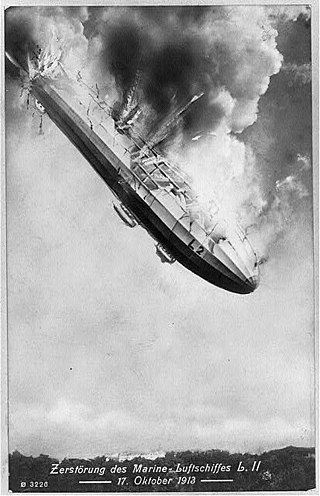
The Johannisthal air disaster involved the Imperial German Navy's L 2 airship manufactured by Luftschiffbau Zeppelin as LZ 18. Its test flight resulted in the death of all 28 passengers and crew on board. On 17 October 1913, at approximately 10:30 am local time, hydrogen gas which was being vented was sucked into the forward engine and ignited causing the airship to explode and burn. It crashed near Johannisthal Air Field about 16 kilometres (10 mi) southeast of Berlin. The accident occurred a little over a month after the Helgoland Island Air Disaster.
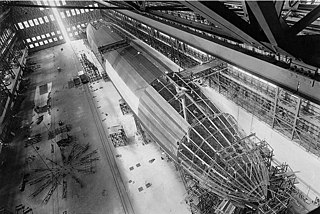
A rigid airship is a type of airship in which the envelope is supported by an internal framework rather than by being kept in shape by the pressure of the lifting gas within the envelope, as in blimps and semi-rigid airships. Rigid airships are often commonly called Zeppelins, though this technically refers only to airships built by the Luftschiffbau Zeppelin company.

DELAG, acronym for Deutsche Luftschiffahrts-Aktiengesellschaft, was the world's first airline to use an aircraft in revenue service. It operated a fleet of zeppelin rigid airships manufactured by the Luftschiffbau Zeppelin Corporation. Its headquarters were located in Frankfurt, Germany.

Captain Ernst August Lehmann was a German Zeppelin captain. He was one of the most famous and experienced figures in German airship travel. The Pittsburgh Press called Lehmann the best airship pilot in the world, although he was criticized by Hugo Eckener for often making dangerous maneuvers that compromised the airships. He was a victim of the Hindenburg disaster in 1937.

The Dixmude was a Zeppelin airship built for the Imperial German Navy as L 72 and unfinished at the end of the First World War, when it was given to France as war reparations and recommissioned in French Navy service and renamed Dixmude. It was lost when it exploded in mid-air on 21 December 1923 off the coast of Sicily, killing all 52 on board. This was one of the earliest of the great airship disasters, preceded by the crash of the British R38 in 1921 and the US airship Roma in 1922, and followed by the destruction of the USS Shenandoah in 1925 the British R101 in 1930, the USS Akron in 1933 and the German Hindenburg in 1937.

The LZ 61 was a World War I German Navy airship, allocated the tactical numbering 'L 21'. It carried out a total of ten raids on England, and 17 reconnaissance missions.
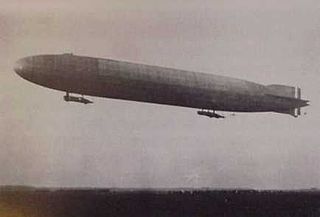
Zeppelin LZ 54, given the military tactical designation L 19, was a Zeppelin of the Imperial German Navy. While returning from her first bombing raid on the United Kingdom in early 1916, she came down in the North Sea. Her crew survived the crash, but drowned after the crew of a British fishing vessel refused to rescue them; at the time this was a widely reported and notorious incident.

The airship LZ 37 was a World War I Zeppelin of the German Kaiserliche Marine. It was the first Zeppelin to be brought down during the war by an enemy plane, on the night of 6 to 7 June 1915.

LZ 18 was the second Zeppelin airship to be bought by the Imperial German Navy. It caught fire and crashed with the loss of all aboard on 17 October 1913 before entering service.
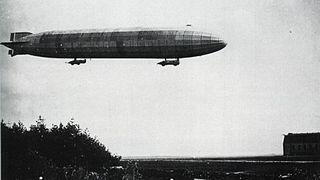
The Zeppelin P Class was the first Zeppelin airship type to be produced in quantity after the outbreak of the First World War. Twenty-two of the type were built as well as twelve of a lengthened version, the Q Class. They were used for many of the airship bombing raids on the United Kingdom in 1915-16, for naval patrol work over the North Sea and Baltic and were also deployed on the eastern and south-eastern fronts.

The Zeppelin R Class was a type of rigid airship developed by Zeppelin Luftschiffbau in 1916 for use by the Imperial German Navy and the German Army for bombing and naval patrol work. Introduced in July 1916 at a time when British air defences were becoming increasingly capable, several were lost in the first months of operation, leading the Germans to reconsider their technical requirements and eventually to develop airships capable of bombing from a greater height. Most surviving examples were modified to meet these requirements, by reducing weight at the expense of performance. A total of 17 were built.

The Zeppelin LZ 23 was the 2nd improved L-class Zeppelin, and the eleventh airship of the Imperial German Army, first flown on 21 February 1914 and shot-down by anti-aircraft fire on 23 August 1914.
Zeppelin LZ 66, Imperial German Navy serial L 23, took part in 51 reconnaissance missions during World War I and on 21 August 1917 it was shot down by Second Lt Bernard A. Smart, flying a Sopwith Pup.
